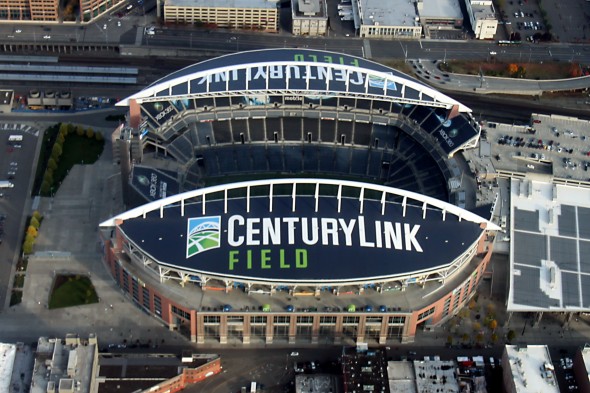
CenturyLink Field was selected as one of 10 U.S. venues to host the Centennial Copa America June 3-26, 2016. The 100th edition of the tournament will be staged outside of South America for the first time and will feature six teams from CONCACAF (Confederation of North, Central America and Caribbean Association Football) and all 10 from CONMEBO (South American Football Confederation). Each venue will host a minimum of three matches.
From CONCACAF, host United States and Mexico are automatic qualifiers, while Costa Rica (2014 Central American Cup winner) and Jamaica (2014 CFU Caribbean Cup winner) qualified with regional championships last year.
The South American field for the tournament includes Argentina, Bolivia, Brazil, Chile, Colombia, Ecuador, Paraguay, Peru, Uruguay and Venezuela. Uruguay has been champion of the Copa America a record 15 times, while Chile won its first title last year.
Other stadiums selected included Chicago’s Soldier Field, Boston’s Gillette Stadium, Houston’s NRG Stadium, Los Angeles’s Rose Bowl, New York’s MetLife Stadium, Philadelphia’s Lincoln Financial Field, Phoenix’s University of Phoenix Stadium, Levi’s Stadium in San Francisco, and the Orlando Citrus Bowl Stadium in the eponymous city. While all the cities hosting save for Phoenix and San Francisco are home to an MLS team, only Seattle and Orlando will use the stadiums in which their MLS teams play.
While the stadiums have clearly been selected with capacity in mind (the smallest capacity for any venue is 63,400 in Phoenix), grumbling will likely ensue regarding the playing surfaces. Of the 10, only four use grass (San Francisco, Chicago, Phoenix and Los Angeles). Five use artificial turf (Seattle, Boston, New York, Houston, Orlando), with the final venue (Philadelphia) using a turf-grass blend.
International soccer officials are usually wary of playing important matches on artificial surfaces, due to the way the ball plays as well as greater impact on players’ legs, which increases the likelihood of injury.
This could mean that the turf venues may be quietly blacklisted from hosting later rounds of the competition, to appease pressure from international organizers. Another option would be the use of temporary grass installations, though this produced farcical results when attempted at the Clink and other venues as part of the International Champions Cup the past two years.
Either way, Seattle and the other four artificial venues, regardless of the soccer culture in their respective cities, will be at a natural disadvantage to host the most important matches when the tournament comes to town in June.
“On behalf of Seattle Sounders FC, we are honored to welcome Copa America Centenario to Seattle next summer,” said Sounders FC owner Adrian Hanauer. “This tournament is the most significant international soccer event to be hosted in our country since the 1994 FIFA World Cup, and we’re thrilled for fans in the Pacific Northwest that will be able to take part at CenturyLink Field in 2016.
“Seattle has a proud history of hosting high-profile soccer events – both domestic and international – and we’re excited to continue that tradition next year with Copa America.”
Dates of the CenturyLink matches are undetermined.

7 Comments
The Copa America might be the oldest but it’s also one of the most disorganized tournaments in the world. First off nobody has to qualify (it’s invite-only) and used to be held biannually. Then it went to every three years starting in 2001 (a year that saw Argentina refuse to attend) which was an incredibly dumb idea since mathematically it would eventually conflict with a World Cup year.
Years ago it used to be a prestigious tournament that was usually won by either Argentina or Uruguay. Now because South American qualifying is a league format (all 10 teams play each other twice) it’s lost a lot of prestige. Most South American countries don’t send their best teams or send a mixture of top players and secondary players.
If they had installed real grass as we were promised as a condition of funding the stadium, hosting later round games and other international matches would be a non-issue.
Many stadiums in Germany, where the climate’s similar to ours, have roofs that cover the entire seating areas yet are made of material that lets through up to 90 percent of sunlight. Grass gets enough sun and the fans stay dry, a win-win. It’s a recent and likely expensive technology, so I don’t know how feasable that or a retractable roof would be for the next CLink upgrade.
As for having turf instead of the planned grass, that was a Seahawks decision, and the NFL outweighs MLS everywhere on turf vs. grass. Also happened in Giants Stadium as well as here and Gillette.
I realize that the Hawks were responsible for the turf (worth pointing out however), but that doesn’t make it right. Even the Hawks games would be better on real grass and players would likely be injured less often ( return on investment anyone?). It would be better for everyone,,, my opinion of course.
Interestingly, a lot of football people prefer turf over grass. Something like better footing, more consistent height of the blades, fewer flat spots and divots. Rugby is beginning to embrace turf for these reasons, too.
I would love something like the University of Phoenix Stadium, where the grass field is on a rollout tray. Leave it in for the Sounders, then crank it outside and use underneath turf during Seahawks games. No place to put it but the north parking lot, though.